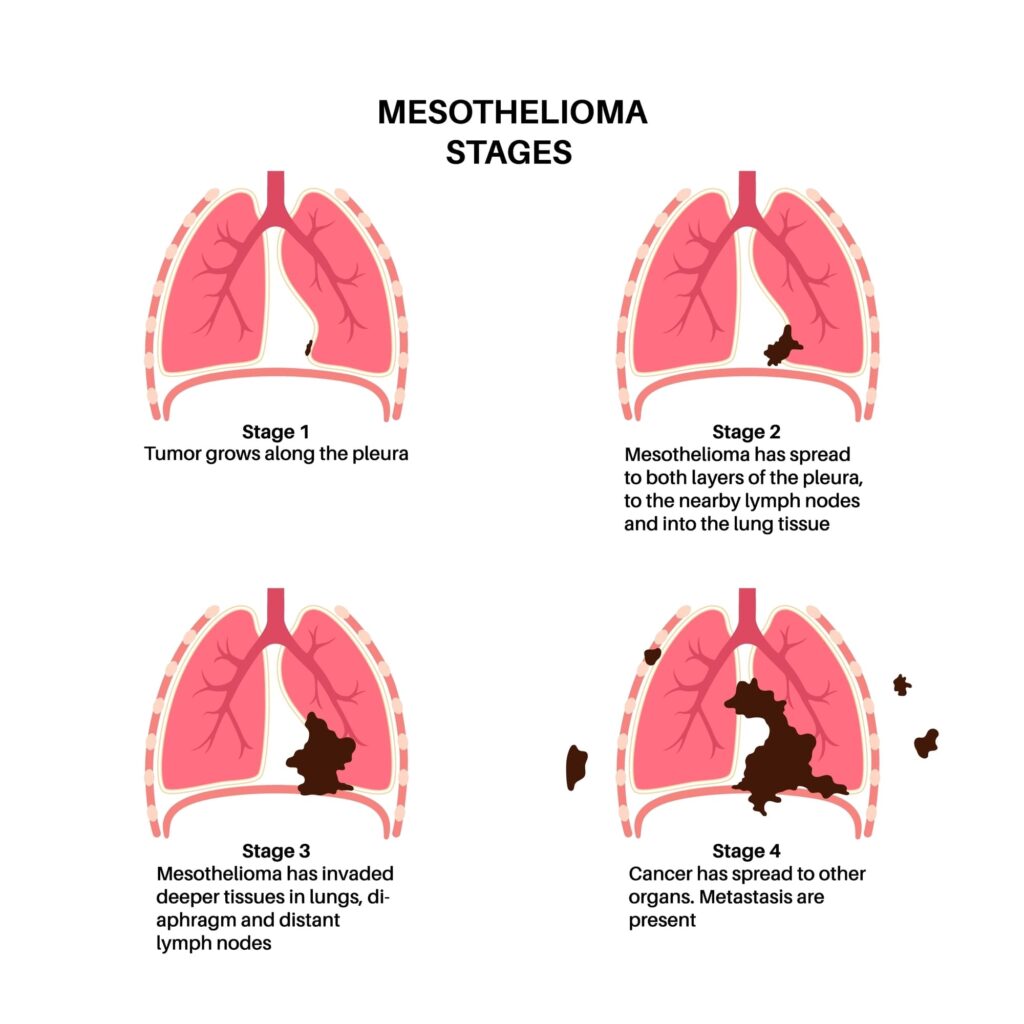Mesothelioma is a rare and aggressive cancer that results primarily from exposure to asbestos. If you receive a diagnosis for this disease, it’s imperative to discuss your case with a doctor as well as a mesothelioma lawyer.
How a Mesothelioma Lawyer Can Help
You can get maximum compensation for your medical care by contacting a mesothelioma lawyer. A mesothelioma attorney can access various resources, including asbestos funds, to ensure you receive the highest settlement possible.
If you have end-stage mesothelioma, receiving money for your care is a priority. The following information will give you more details about mesothelioma and an overview of this cancer when it advances to stage 4.
Mesothelioma Defined
Mesothelioma is a cancer that mainly affects the lining of the lungs (called pleural mesothelioma) and the lining of the abdomen (peritoneal mesothelioma). Pericardial mesothelioma may also affect the lining of the heart. The disease develops after a long latency period (10 to 50 years), so it’s often diagnosed after it reaches an advanced stage.
The Staging System
When mesothelioma is staged, it is classified using the TNM system. This system is known as “TNM” to categorize the primary mesothelioma – pleural mesothelioma or the mesothelioma that affects the lining of the lungs.
- T stands for “Tumor” – and the size and extent of a primary tumor
- N stands for Lymph “Nodes” – and indicates if the cancer has spread to nearby lymph nodes
- M refers to “Metastasized” and indicates the spreading of the cancer to the other parts of the body
Based on the above staging factors, pleural mesothelioma is classified into four stages, as follows:
- Stage 1 – The tumors of the cancer are localized and have not yet spread.
- Stage 2 – The tumors have spread to nearby locations but are still contained to some degree
- Stage 3 – The tumors have spread further from the area where they originally developed
- Stage 4 – The tumors are found in other parts of the body as well as the original site

Based on the above information, stage 4 pleural mesothelioma is characterized by an extensive spread of the disease, tumors are usually more numerous and large, with more intense and frequent symptoms. Treatment options are limited, thereby shifting the focus on palliative care over curative treatments.
Palliative care is primarily concerned with improving the patient’s quality of life and managing their symptoms. Chemotherapy is the primary curative treatment during this stage.
Signs and Symptoms of End-Stage Mesothelioma
The symptoms of end-stage mesothelioma can vary depending on the type (pleural, peritoneal, or pericardial mesothelioma) and the extent of the disease. Common signs and symptoms include:
- Severe chest or abdominal pain (depending on whether you have pleural or peritoneal mesothelioma)
- Difficulty breathing (dyspnea)
- Persistent cough, often accompanied by coughing up blood (hemoptysis)
- Fatigue and weakness
- Unexplained weight loss
- Night sweats and fever
- Difficulty swallowing (dysphagia)
- Abdominal swelling and fluid buildup (ascites) in cases of peritoneal mesothelioma
- Pleural effusion (fluid buildup around the lungs) when experiencing pleural mesothelioma
- Anemia
- Loss of appetite
- Nausea and vomiting
- Bowel obstruction (in cases of peritoneal mesothelioma)
- Cognitive changes or confusion
- Increased susceptibility to infections
It’s important to note that these symptoms can vary in intensity and may not all be present in every case. The progression of symptoms can also differ from person to person.
Getting a Diagnosis for End-Stage Mesothelioma: Why It Is Difficult
Diagnosing end-stage mesothelioma can be challenging for several reasons:
- Similarity to other conditions: Many symptoms of end-stage mesothelioma are similar to those of other respiratory or abdominal diseases, making an initial diagnosis difficult.
- Rapid progression: Mesothelioma can progress quickly, and patients may already be in the advanced stages by the time they seek medical care and attention.
- Long latency period: Mesothelioma typically develops 20 to 50 years after asbestos exposure, making it difficult to connect a patient’s current symptoms with past asbestos exposure.
- Variability in presentation: The disease can manifest differently in each patient, complicating the diagnosis.
- Imaging limitations: While imaging tests can detect the presence of tumors, they may not always definitively identify mesothelioma.
Diagnostic Tests and Tools
Despite diagnostic challenges, several diagnostic tools and tests are used to identify mesothelioma:

- Imaging tests: CT scans, MRIs, and PET scans can help visualize tumors and assess the scope of the cancer.
- Blood tests: Certain biomarkers in the blood, such as mesothelin-related peptide (SMRP) and osteopontin, can indicate the presence of mesothelioma.
- Biopsies: Tissue samples are obtained for microscopic examination to confirm a diagnosis and determine the cell type.
- Thoracoscopy or laparoscopy: These minimally invasive procedures allow doctors to visually examine the affected areas and take tissue samples.
- Cytology: Analysis of fluid samples from the lungs or abdomen can help detect cancer cells.
Treatment Options for End-Stage Mesothelioma
Again, treatment for end-stage mesothelioma primarily focuses on palliative care, which is designed to improve a person’s quality of life and manage symptoms. Some treatments may be used to slow disease progression. Treatment options may include:
- Palliative chemotherapy: To shrink tumors and alleviate symptoms.
- Radiation therapy: To reduce tumor size and manage pain.
- Immunotherapy: To boost the body’s immune response against cancer cells.
- Palliative surgery: To remove fluid buildup or relieve pressure on organs.
- Pain management: Using medications and other techniques to control pain.
- Oxygen therapy: To assist with breathing difficulties.
- Nutritional support: To maintain strength and manage weight loss.
- Complementary therapies: Such as acupuncture or massage to help manage symptoms and improve quality of life.
Timeline for Survival of End-Stage Mesothelioma: Speak to a Lawyer to Ensure Better Results and Improve Your Survival Rate
Typically, end-stage mesothelioma has a timeline of 6 to 26 months after a patient is diagnosed. Patients who choose treatment over non-treatment will usually live longer. Therefore, discussing your case with a mesothelioma lawyer can help improve your quality of life and get the funds you need to increase survival time.
Pleural Mesothelioma Timeline
The life expectancy for stage 4 pleural mesothelioma patients is usually one year. When patients opt for treatment, the percentage of patients who survive after a year does increase.
Some treatments improve life expectancy, such as checkpoint inhibitors and multimodal treatments. A multimodal treatment involves more than one treatment plan.
Treatment Plans and Survival Rates for End-Stage Pleural Mesothelioma
The following information provides the life expectancy based on the treatment plan:
- Systemic Chemotherapy – Life expectancy: 11 months
- Checkpoint Inhibitor Immunotherapy – Life expectancy: 16 months
- Multimodal Treatment – Life expectancy – 23 months
- No treatment – Life expectancy – 6 months
On average, the life expectancy is 26 months, with treatment for peritoneal mesothelioma. Of the patients who undergo therapy, around 63 percent survive after one year and 40 percent after three years.
Several factors can influence a person’s life expectancy. For instance, a patient treated with surgery may live longer than a patient who only receives chemotherapy.
End-Stage Peritoneal Mesothelioma

No TNM staging system is used specifically for peritoneal mesothelioma of the abdomen. Instead, a mesothelioma doctor uses the peritoneal cancer index (PCI) to stage this type of cancer.
A PCI system divides the abdomen into nine areas, each having a score based on the size of the tumor in that specific area. A doctor determines the stage based on the total score. Stage 4 peritoneal mesothelioma has an overall PCI score that ranges from 31 to 39.
At the end-stage, the tumors may have metastasized to the chest wall, nearby lymph nodes, and other far organs and tissues.
When patients opt for treatment, the one-year survival rate for stage 4 peritoneal mesothelioma is about 63 percent. The three-year survival rate is around 40 percent for treated patients, stressing the importance of therapy and care.
Pericardial and Testicular End-Stage Mesothelioma Survival Statistics
Staging systems are not established for pericardial and testicular end-stage mesothelioma. Survival rates, regardless of progression then, are six months for patients with pericardial mesothelioma and around six years for patients with testicular mesothelioma.
Legal Considerations: Why You Should Speak to an Attorney Skilled in Mesothelioma Cases

Given that mesothelioma is primarily caused by asbestos exposure, many patients and their families are entitled to compensation. Working with an experienced mesothelioma attorney can be beneficial for several reasons:
- Understanding the laws: Asbestos litigation involves a thorough knowledge of state and federal laws.
- Identifying the responsible parties: Experienced attorneys can help identify all potentially liable parties.
- Maximizing compensation: Knowledgeable lawyers can help ensure that all applicable damages are pursued.
- Handling time-sensitive matters: Given the aggressive nature of mesothelioma, experienced attorneys understand the importance of expediting legal proceedings.
- No upfront costs: Most mesothelioma attorneys work on a contingency basis, meaning they only get paid if you receive compensation.
- Support for families: Attorneys can continue to pursue claims on behalf of the family even after a patient’s passing.
Contact a Mesothelioma Attorney Now, If You’ve Been Diagnosed with Mesothelioma
The urgency of care is stressed when your mesothelioma has advanced. That is why it’s important to contact a qualified mesothelioma attorney at Vogelzang Law. They can provide you with the maximum compensation you need to manage your condition, take care of your family, and make the most of your quality of life.



